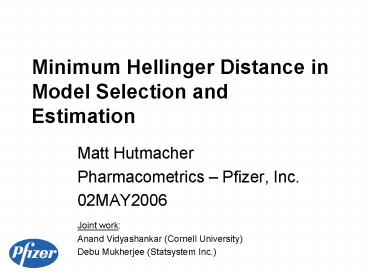Matt Hutmacher - PowerPoint PPT Presentation
1 / 30
Title:
Matt Hutmacher
Description:
Need for better model selection techniques. Subject matter can ... Loess, kernel smoother, mean. gn true mi under mild conditions. Estimate sg2 using residuals ... – PowerPoint PPT presentation
Number of Views:55
Avg rating:3.0/5.0
Title: Matt Hutmacher
1
Minimum Hellinger Distance in Model Selection and
Estimation
- Matt Hutmacher
- Pharmacometrics Pfizer, Inc.
- 02MAY2006
Joint work Anand Vidyashankar (Cornell
University) Debu Mukherjee (Statsystem Inc.)
2
Introduction
- Initiated by a conversation on model selection
between non-nested models
- Collaboration ensued
- Need for better model selection techniques
- Subject matter can not always provide model form
- Empirical models often used in exposure-response
- Nonlinear mixed effects is flexible with respect
to model forms - Marginal variance depends upon model form
- Population modelers (pharmacometricians) are
well-suited for developing and applying new
data-analytic techniques to enhance decision
making
3
Objective
- Introduce Hellinger Distance as a principled
methodology for selection between nonhierarchical
models
- Introduce the concept of minimizing the Hellinger
Distance as an efficient yet robust estimator
an alternative to the MLE (or ELS)
4
Outline
- What is Hellinger Distance (HD)
- HD applied to Model Selection
- Minimum Hellinger Distance Estimation (MHDE)
- Remarks
5
What is Hellinger Distance
- Definition
2
- An absolute measure between two densities
- HD 0 when f ? g
- Ranges between 0 and 2 inclusive
6
What is Hellinger Distance
- HD for two univariate normal densities
1
1
- Easy to extend to a multivariate normal for
population models
7
HD for Model Selection
- Likelihood based methods are popular for model
selection - LRT (asymptotic ?2)
- Akaike information criterion
- Schwarzs Bayesian information criterion (BIC or
SBC)
- All are comparative methods
8
HD for Model Selection
- AIC and BIC often applied to nonhierarchical
model selection
- Yet, AIC and BIC were developed under the
hierarchical construct
- How robust are these likelihood based procedures
to likelihood misspecification or outliers?
- Isnt the analyst interested ultimately in a
model that is closest to the underlying model?
9
HD for MS (Implementation)
- Consider selecting between f1 and f2
- How do we proceed?
10
HD for MS (Implementation)
- Compare models to a nonparametric assessment of
model form
- Estimate mg,i nonparametrically (gn)
- Loess, kernel smoother, mean
- gn ? true mi under mild conditions
- Estimate sg2 using residuals
11
HD for MS (Implementation)
- Compare models to a non-parametric assessment of
model form (cont.)
- Compute HD(f1,g) and HD(f2,g)
- Select the f with the smallest HD
12
HD for Model Selection (Examples)
- Example 1
- Emax model e
- True model
- 3 parameters
- Emax model ? exp(e)
- False model
- 3 parameters
- lt25 CV
- 2000 simulations
13
HD for Model Selection (Examples)
- Example 2
- Emax e
- True model
- 3 parameters
- Linear e
- False model
- 2 parameters
- 10 outliers
- 4-6 s range
- 2000 simulations
14
HD for Model Selection
- HD for model selection
- Targets the closest parametric model to the
assumption-poor nonparametric model - Closeness defined with respect to the first two
moments (mean, variance)
- Currently for non-hierarchical models
- HD will select larger model without penalty
- Similar to 2ll in this respect
- Working on an appropriate penalty
15
Minimum HD Estimation (MHDE)
- Recall HD definition
- Consider
- Why not estimate q ?
16
Minimum HD Estimation (MHDE)
- HD (or g) is a well-defined objective function
(bounded)
- Suggests minimizing HD or maximizing g for
estimation of q Beran (1977)
17
Minimum HD Estimation
- Integral evaluation
- Integral by SLLN Cheng Vidyashankar (2003)
18
Minimum HD Estimation
- Sampling
- Calculate residuals
19
Minimum HD Estimation
- Estimate the density of the residuals
20
Minimum HD Estimation
- Recall
- For j-th term in the integral approximation
- Sample a Ki with probability p such as 1/n (i)
21
Minimum HD Estimation
- Optimization over q is now possible
- Optimization can be performed using SAS PROC NLP
(or PROC MODEL)
- These routines support several optimization
routines, convergence criteria, and symbolic
differentiation
22
MHDE (Examples)
- Example 3
- N50
23
MHDE (Examples cont.)
- Example 4
- Compare MLE and MHDE
- Sample size n20
- 1000 Simulations
24
MHDE (Example 4)
25
MHDE (Examples cont.)
- Example 5
- Compare MLE (ELS) and MHDE
- Sample size n20
- 1000 Simulations
26
MHDE (Example 5)
27
Remarks
- Properties of a good estimator
- Efficient when model is true
- Not much loss when model is approximately true
- MLE (ELS)
- Is efficient when the model is true
- Can suffer instability under data contamination
(inefficiencies and lack of robustness) - Uses a squared error with a penalty for
increasing the variance
28
MHDE
- MHDE is efficient with increased robustness
- Efficient when model is true
- Increased efficiency relative to total
nonparametric estimation - MHDEs use of the empirical density
(nonparametric kernel density) estimator reduces
the influence of outliers and data contamination - Empirical density puts mass of 1/n on data ( is
do to the smoothing) - Some experience with choosing cn is necessary to
get comfortable with the method
29
Remarks
- Novel methodology
- Smoothed mixture of kernels to emulate empirical
density of data - Makes MHDE generalizable to more typical
data-analytic problems - Regression
- ANOVA / ANCOVA / Partial Linear Models
- Well-suited to adequately simulate data
- Simulate from smoothed empirical data
distribution
30
Remarks
- This estimation methodology reflects a conceptual
shift away from the likelihood and towards
density. - Minimum Hellinger Distance Estimation provides an
alternate, efficient (yet robust) inferential
strategy and a unique data simulation methodology - Mixed effects methodology under development































